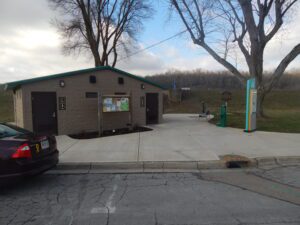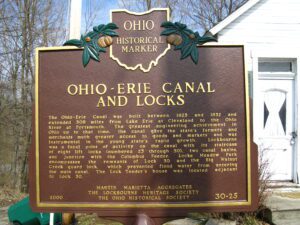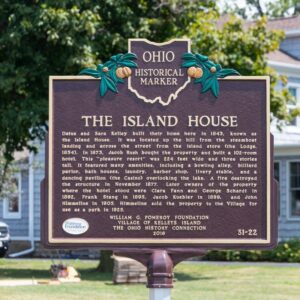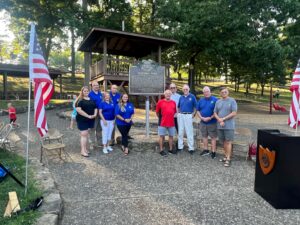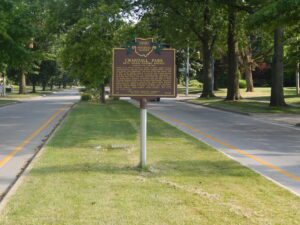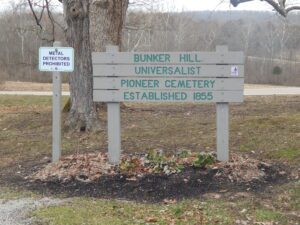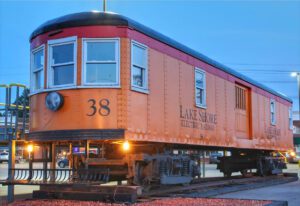, OH
In late March 1913, a series of three severe rainstorms inundated the already saturated and frozen ground of the Miami Valley, causing one of Ohio’s greatest natural disasters, the Flood of 1913. On March 25, the Great Miami River overflowed its banks at Miamisburg, fed by runoff from Bear and Sycamore creeks. Homes, businesses, and the bridges at Linden Avenue and Sycamore Street were swept away or wrecked by floodwaters reaching as high as eleven feet on Main and First streets. Early reports indicated that six people in the area died. Cleanup and recovery efforts took approximately a year. (Continued on other side)
, OH
The Ohio-Erie Canal was built between 1825 and 1832 and extended 308 miles from Lake Erie at Cleveland to the Ohio River at Portsmouth. The greatest engineering achievement in Ohio up to that time, the canal gave the state’s farmers and merchants much greater access to goods and markets and was instrumental in the young state’s rapid growth. Lockbourne was a focal point of activity on the canal with its staircase of eight lift locks (numbered 23 through 30), two canal basins, and junction with the Columbus Feeder. Locke Meadow Park encompasses the remnants of Lock 30 and the Big Walnut Creek guard lock, which prevented flood water from entering the main canal. The Lock Tender’s house was located adjacent to Lock 30.
, OH
The Ohio-Erie Canal was built between 1825 and 1832 and extended 308 miles from Lake Erie at Cleveland to the Ohio River at Portsmouth. The greatest engineering achievement in Ohio up to that time, the canal gave the state’s farmers and merchants much greater access to goods and markets and was instrumental in the young state’s rapid growth. Lockbourne was a focal point of activity on the canal with its staircase of eight lift locks (numbered 23 through 30), two canal basins, and junction with the Columbus Feeder. Locke Meadow Park encompasses the remnants of Lock 30 and the Big Walnut Creek guard lock, which prevented flood water from entering the main canal. The Lock Tender’s house was located adjacent to Lock 30.
, OH
Datus and Sara Kelley built their home here in 1843, known as the Island House. It was located up the hill from the steamboat landing and across the street from the island store (the Lodge, 1854). In 1873, Jacob Rush bought the property and built a 102-room hotel. This “pleasure resort” was 224 feet wide and three stories tall. It featured many amenities, including a bowling alley, billiard parlor, bath houses, laundry, barber shop, livery stable, and a dancing pavilion (the Casino) overlooking the lake. A fire destroyed the structure in November 1877. Later owners of the property where the hotel stood were Clara Fann and George Schardt in 1892, Frank Stang in 1895, Jacob Kuebler in 1899, and John Himmeline in 1905. Himmeline sold the property to the Village for use as a park in 1925.
, OH
Tuscora Park, on land once owned by Jeremiah Reeves, opened as a private amusement park on June 1, 1907. Despite rain, the grand opening brought thousands of visitors to the park. Throughout the summer months, large crowds enjoyed such features as a swimming pool, sea wave, restaurant, dancing pavilion, and twice-daily free band concerts. The park also featured athletic facilities for running, tennis, baseball, and bowling. After Tuscora Park was sold in a November 1911 Sheriff’s sale, New Philadelphia’s City Council authorized its purchase along with additional surrounding acreage and received the deeds on June 21, 1912. Originally billed as the “Coney Island of Eastern Ohio,” Tuscora continues to operate as a city-owned park that draws both local residents and visitors to its picnic grounds, vintage rides, swimming pool, and athletic facilities. (Continued on other side)
, OH
Crandall Park is the heart of the historic district and includes Fifth Avenue, Redondo Road, Catalina Avenue, and Tod Lane. Most of the district’s historic structures were built between 1904 and 1930, Youngstown’s heyday as an urban and industrial center. The district encompasses 92 houses, 32 outbuildings, a pavilion and rustic stone shelter in Crandall Park, and the concrete arch bridge carrying Fifth Avenue over the park. The North Heights Land Company and the Realty Guarantee Trust Company developed much of the neighborhood. Homes in the district were built for the city’s prominent industrialists and businessmen. The houses feature the work of architects Morris Scheibel, Charles F. Owsley, Fred Medicus, Barton Brooke, and Cook and Canfield and are distinguished by their grand scale, high-style design, spacious lots, landscaping, and orientation to the park or boulevard roads. (Continued on other side)
, OH
The Bunker Hill Society was organized about 1845 and fellowshipped in 1854. A frame meeting house, capable of seating 300, was dedicated in 1855. Thirty people united with the church during teh 1859 Annual Meeting. The membership suffered greatly during the Civil War, many enlisting in the Union Army. Some members, Like John G. Agnew, were Peace Democrats (Copperheads). Agnew withdrew from the church on July 5, 1863 saying, “I feel the course I am and have been pursuing does not comport with the Christian character. Nor do I think that I can be better while this war lasts. I do not wish to be a reproach upon the church.” The church was re-fellowshipped in 1900. The last sermon was delivered October 23, 1910. Fire destroyed the building May 8, 1924.
, OH
From the 1890s to the 1930s, interurban railways were an important form of travel in the Midwest. Beach Park Station had an interurban carhouse, where repairs were performed and passengers boarded. The Lorain & Cleveland Railway (L&C) built the 65½ by 200 foot brick station in 1897. By 1901, the L&C became part of the Lake Shore Electric Railway (LSE) and Beach Park became stop 65 on a line that ran from Cleveland to Toledo and then to Detroit. Requiring power and water, the LSE built an electric plant and water tower at Avon Lake. This infrastructure spurred the community’s development and growth. (Continued on other side


